
Djadochta Formation
Encyclopedia
The Djadochta Formation (sometimes transcribed
Djadokhta) is situated in central Asia
(Gobi Desert
) and dates from the Late Cretaceous
Period. Laid down in the early Campanian
, possibly starting in the latest Santonian
, it is dated somewhat uncertainly at about 84-75 mya (million years ago). The type locality
are the famous "Flaming Cliffs
", locally known as Bayanzag ("rich in Haloxylon
") or Ulaan-Ereg ("red cliffs").
It preserves an arid
habitat of sand dune
s, with little freshwater
apart from oases and arroyos
. In fact, the present-day climate at most Djadochta Formation sites differs little from what it was some 80 mya, except by being somewhat warmer and perhaps a bit less arid then. This is testimony to the fact that the location has long been so far from any major source of evaporation
that little rainfall reached it, even before the Himalayas
were uplifted which bar cloud
s from reaching today's Gobi desert.
Most notable fossil
discoveries have been the first confirmed dinosaur
eggs (a clutch
, probably of Oviraptor
) and several dinosaur finds, Protoceratops
, Pinacosaurus
and Velociraptor
being the most prominent.

. The two share many of the same genera, but differ in the exact species. For example, the most common mammal in the Djadochta is Kryptobaatar dashzevegi, while in the Bayan Mandahu, it is the closely related Kryptobaatar mandahuensis. Similarly, the dinosaur fauna of the Djadochta includes Protoceratops andrewsi and Velociraptor mongoliensis, which the Bayan Mandahu yields Protoceratops hellenikorhinus and Velociraptor osmolskae. It is likely that the nearby Bayn Mandahu represents a slightly younger, perhaps by 1 million years, assemblage of slightly more derived animals, possibly the direct descendants of their Djadochta counterparts.
Transcription (linguistics)
Transcription in the linguistic sense is the systematic representation of language in written form. The source can either be utterances or preexisting text in another writing system, although some linguists only consider the former as transcription.Transcription should not be confused with...
Djadokhta) is situated in central Asia
Asia
Asia is the world's largest and most populous continent, located primarily in the eastern and northern hemispheres. It covers 8.7% of the Earth's total surface area and with approximately 3.879 billion people, it hosts 60% of the world's current human population...
(Gobi Desert
Gobi Desert
The Gobi is a large desert region in Asia. It covers parts of northern and northwestern China, and of southern Mongolia. The desert basins of the Gobi are bounded by the Altai Mountains and the grasslands and steppes of Mongolia on the north, by the Hexi Corridor and Tibetan Plateau to the...
) and dates from the Late Cretaceous
Cretaceous
The Cretaceous , derived from the Latin "creta" , usually abbreviated K for its German translation Kreide , is a geologic period and system from circa to million years ago. In the geologic timescale, the Cretaceous follows the Jurassic period and is followed by the Paleogene period of the...
Period. Laid down in the early Campanian
Campanian
The Campanian is, in the ICS' geologic timescale, the fifth of six ages of the Late Cretaceous epoch . The Campanian spans the time from 83.5 ± 0.7 Ma to 70.6 ± 0.6 Ma ...
, possibly starting in the latest Santonian
Santonian
The Santonian is an age in the geologic timescale or a chronostratigraphic stage. It is a subdivision of the Late Cretaceous epoch or Upper Cretaceous series. It spans the time between 85.8 ± 0.7 mya and 83.5 ± 0.7 mya...
, it is dated somewhat uncertainly at about 84-75 mya (million years ago). The type locality
Type locality (geology)
Type locality , also called type area or type locale, is the where a particular rock type, stratigraphic unit, fossil or mineral species is first identified....
are the famous "Flaming Cliffs
Flaming Cliffs
The Flaming Cliffs site, really Bayanzag , is a region of the Gobi Desert in the Ömnögovi Province of Mongolia, in which important fossil finds have been made. It was given this name by American paleontologist Roy Chapman Andrews, who visited in the 1920s. The area is most famous for yielding the...
", locally known as Bayanzag ("rich in Haloxylon
Haloxylon
Haloxylon is a genus of shrubs or small trees, belonging to the plant family Amaranthaceae. Haloxylon and its species are known by the common name saxaul.-Description:...
") or Ulaan-Ereg ("red cliffs").
It preserves an arid
Arid
A region is said to be arid when it is characterized by a severe lack of available water, to the extent of hindering or even preventing the growth and development of plant and animal life...
habitat of sand dune
Dune
In physical geography, a dune is a hill of sand built by wind. Dunes occur in different forms and sizes, formed by interaction with the wind. Most kinds of dunes are longer on the windward side where the sand is pushed up the dune and have a shorter "slip face" in the lee of the wind...
s, with little freshwater
Freshwater
Fresh water is naturally occurring water on the Earth's surface in ice sheets, ice caps, glaciers, bogs, ponds, lakes, rivers and streams, and underground as groundwater in aquifers and underground streams. Fresh water is generally characterized by having low concentrations of dissolved salts and...
apart from oases and arroyos
Arroyo (creek)
An arroyo , a Spanish word translated as brook, and also called a wash is usually a dry creek or stream bed—gulch that temporarily or seasonally fills and flows after sufficient rain. Wadi is a similar term in Africa. In Spain, a rambla has a similar meaning to arroyo.-Types and processes:Arroyos...
. In fact, the present-day climate at most Djadochta Formation sites differs little from what it was some 80 mya, except by being somewhat warmer and perhaps a bit less arid then. This is testimony to the fact that the location has long been so far from any major source of evaporation
Evaporation
Evaporation is a type of vaporization of a liquid that occurs only on the surface of a liquid. The other type of vaporization is boiling, which, instead, occurs on the entire mass of the liquid....
that little rainfall reached it, even before the Himalayas
Himalayas
The Himalaya Range or Himalaya Mountains Sanskrit: Devanagari: हिमालय, literally "abode of snow"), usually called the Himalayas or Himalaya for short, is a mountain range in Asia, separating the Indian subcontinent from the Tibetan Plateau...
were uplifted which bar cloud
Cloud
A cloud is a visible mass of liquid droplets or frozen crystals made of water and/or various chemicals suspended in the atmosphere above the surface of a planetary body. They are also known as aerosols. Clouds in Earth's atmosphere are studied in the cloud physics branch of meteorology...
s from reaching today's Gobi desert.
Most notable fossil
Fossil
Fossils are the preserved remains or traces of animals , plants, and other organisms from the remote past...
discoveries have been the first confirmed dinosaur
Dinosaur
Dinosaurs are a diverse group of animals of the clade and superorder Dinosauria. They were the dominant terrestrial vertebrates for over 160 million years, from the late Triassic period until the end of the Cretaceous , when the Cretaceous–Paleogene extinction event led to the extinction of...
eggs (a clutch
Clutch (eggs)
A clutch of eggs refers to all the eggs produced by birds or reptiles, often at a single time, particularly those laid in a nest.In birds, destruction of a clutch by predators, , results in double-clutching...
, probably of Oviraptor
Oviraptor
Oviraptor is a genus of small Mongolian theropod dinosaur, first discovered by the paleontologist Roy Chapman Andrews, and first described by Henry Fairfield Osborn, in 1924...
) and several dinosaur finds, Protoceratops
Protoceratops
Protoceratops is a genus of sheep-sized herbivorous ceratopsian dinosaur, from the Upper Cretaceous Period of what is now Mongolia. It was a member of the Protoceratopsidae, a group of early horned dinosaurs...
, Pinacosaurus
Pinacosaurus
Pinacosaurus is a genus of medium-sized ankylosaur dinosaurs that lived from the late Santonian to the late Campanian stages of the late Cretaceous Period , in Mongolia and China...
and Velociraptor
Velociraptor
Velociraptor is a genus of dromaeosaurid theropod dinosaur that existed approximately 75 to 71 million years ago during the later part of the Cretaceous Period. Two species are currently recognized, although others have been assigned in the past. The type species is V. mongoliensis; fossils...
being the most prominent.

Flora and fauna
The fauna of the Djadochta Formation is very similar in composition to the nearby Bayan Mandahu FormationBayan Mandahu Formation
The Bayan Mandahu Formation is a geological unit of "redbeds" located near the village of Bayan Mandahu in Inner Mongolia, China Asia and dates from the Late Cretaceous Period...
. The two share many of the same genera, but differ in the exact species. For example, the most common mammal in the Djadochta is Kryptobaatar dashzevegi, while in the Bayan Mandahu, it is the closely related Kryptobaatar mandahuensis. Similarly, the dinosaur fauna of the Djadochta includes Protoceratops andrewsi and Velociraptor mongoliensis, which the Bayan Mandahu yields Protoceratops hellenikorhinus and Velociraptor osmolskae. It is likely that the nearby Bayn Mandahu represents a slightly younger, perhaps by 1 million years, assemblage of slightly more derived animals, possibly the direct descendants of their Djadochta counterparts.
Crocodylomorphs
| Crocodylomorphs of the Djadochta Formation | ||||||
|---|---|---|---|---|---|---|
| Genus | Species | Location | Stratigraphic position | Abundance | Notes | |
Gobiosuchus Gobiosuchus Gobiosuchus was a gobiosuchid crocodyliform described in 1972 by Polish palaeontologist Halszka Osmólska. It hails from the Late Cretaceous of Bayn Dzak , in the Gobi Desert of Mongolia.... |
G. kielanae |
A gobisuchid Gobiosuchidae Gobiosuchidae is a family of Late Cretaceous crocodyliforms that lived in what is now the Gobi Desert in Mongolia.- Genera :The two genera currently classified within Gobiosuchidae are Gobiosuchus and Zaraasuchus.- Synapomorphies :... . |
||||
Shamosuchus Shamosuchus Shamosuchus is an extinct genus of neosuchian crocodile that lived during the Late Cretaceous period in what is now the Gobi desert of Mongolia, approximately 85 to 65 million years ago. The teeth were adapted to crush bivalves, gastropods and other animals with a shell or exoskeleton . The genus... |
S. djadochtaensis |
A mesoeucrocodylia Mesoeucrocodylia Mesoeucrocodylia is the name of the clade that includes Eusuchia and the paraphyletic group Mesosuchia. The group appeared during the Early Jurassic, and continues to the present day.... n. |
||||
Zaraasuchus Zaraasuchus Zaraasuchus was a gobiosuchid crocodyliform described in 2004 by Diego Pol and Mark Norell. It was found in the Red Beds of Zos Canyon, in the Gobi Desert of Mongolia, thus making it Late Cretaceous in age.... |
Z. shepardi |
A gobisuchid. | ||||
Zosuchus Zosuchus Zosuchus is a genus of basal, Late Cretaceous crocodyliform from the Redbeds of Zos Canyon in the Gobi Desert of Mongolia. It was discovered by expeditions organized by the American Museum of Natural History, and described by palaeontologists Diego Pol and Mark Norell.The type species is Z... |
Z. davidsoni |
A basal crocodyliform Crocodyliformes Crocodyliformes is a clade of crurotarsan archosaurs, the group often traditionally referred to as "crocodilians."In 1988, Michael J. Benton and James M. Clark argued that all traditional names for well-known groups of animals should be restricted to their crown clades, that is, used only for... . |
||||
Lizards
| Lizard Lizard Lizards are a widespread group of squamate reptiles, with nearly 3800 species, ranging across all continents except Antarctica as well as most oceanic island chains... s of the Djadochta Formation |
|||||||
|---|---|---|---|---|---|---|---|
| Genus | Species | Location | Stratigraphic position | Abundance | Notes | Images | |
Aiolosaurus Aiolosaurus Aiolosaurus is an extinct genus of monitor lizard from the Late Cretaceous of Mongolia. The type and only species, A. oriens, was named in 2000 from Ukhaa Tolgod, a rich fossil site in the Campanian-age Djadochta Formation.-Description and history:... |
A. oriens |
 |
|||||
Anchaurosaurus |
A. gilmorei |
A primitive iguanid Iguanidae Iguanidae is a family of lizards, composed of iguanas and related species.-Classification of Iguanidae:Two different classification schemes have been used to define the structure of this family. These are the "traditional" classification and the classification presented by Frost et al. .Frost et... . |
|||||
Estesia Estesia Estesia is an extinct genus of Late Cretaceous helodermatoid lizard found in the Gobi Desert in Mongolia. It was discovered in June 1990 by a joint expedition made up of Mongolian and American palaeontologists, and described in 1992 by Mark Norell, Malcolm McKenna and Michael Novacek... |
E. mongoliensis |
An anguimorph Anguimorpha Anguimorphs of the infraorder Anguimorpha include the anguids , monitor lizards, the extinct mosasaurs, and helodermatids . The infraorder was named by Fürbringer in 1900 to include all autarchoglossans closer to Varanus and Anguis than Scincus... . |
|||||
Gobiderma Gobiderma Gobiderma is an extinct genus of Late Cretaceous lizard whose fossils are known from the Gobi Desert in southern Mongolia. It was first discovered as a result of a joint Polish-Mongolian Paleontological Expedition, and formally named in 1984... |
G. pulchra |
An anguimorph. | |||||
Mimeosaurus |
M. crassus |
An agamid Agamidae Agamids, lizards of the family Agamidae, include more than 300 species in Africa, Asia, Australia, and a few in Southern Europe. Many species are commonly called dragons or dragon lizards. Phylogenetically they may be sister to the Iguanidae, and have a similar appearance. Agamids usually have... . |
|||||
Pleurodontagama |
P. aenigmatodes |
An agamid. | |||||
Priscagama |
P. gobiensis |
An agamid. | |||||
Xihaina |
X. aquilonia |
A primitive iguanid. | |||||
Mammals
| Mammal Mammal Mammals are members of a class of air-breathing vertebrate animals characterised by the possession of endothermy, hair, three middle ear bones, and mammary glands functional in mothers with young... s of the Djadochta Formation |
||||||
|---|---|---|---|---|---|---|
| Genus | Species | Location | Stratigraphic position | Abundance | Notes | Images |
Bulganbaatar Bulganbaatar Bulganbaatar is a Central Asian mammal genus from the Upper Cretaceous. It existed in the company of dinosaurs. This animal was a member of the extinct order Multituberculata. It's within the suborder Cimolodonta and is a member of the superfamily Djadochtatherioidea. The genus Bulganbaatar was... |
B. nemegtbaataroides |
A marsupial Marsupial Marsupials are an infraclass of mammals, characterized by giving birth to relatively undeveloped young. Close to 70% of the 334 extant species occur in Australia, New Guinea, and nearby islands, with the remaining 100 found in the Americas, primarily in South America, but with thirteen in Central... . |
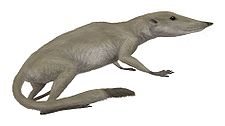 |
|||
Deltatheridium Deltatheridium Deltatheridium is an extinct species of metatherian. It lived in what is now Mongolia during the Upper Cretaceous. It was a basal metatherian, which places it near start of the linage that led to the marsupials, such the kangaroo, koala, and opossum.It had a length of... |
D. pretrituberculare |
A marsupial. |
||||
Deltatheroides |
D. cretacicus |
A marsupial. |
||||
Hyotheridium Hyotheridium Hyotheridium is a possible Eutherian from the Late Cretaceous Djadochta Formation of Mongolia. It could be also be a Deltatheriid, although the fossil, a poorly preserved skull with the upper and lower jaws connected in a way that makes them hard to separate and to examine, makes it difficult to... |
H. dobsoni |
A theria Theria Theria is a subclass of mammals that give birth to live young without using a shelled egg, including both eutherians and metatherians . The only omitted extant mammal group is the egg-laying monotremes.... n mammal of uncertain classification. |
||||
Kamptobaatar Kamptobaatar Kamptobaatar is a Mongolian mammal genus from the Upper Cretaceous. It lived at the same time as the later dinosaurs. This animal was a member of the extinct order Multituberculata within the suborder Cimolodonta and family Sloanbaataridae.... |
K. kuczynskii |
A multituberculate. |
||||
Kennalestes Kennalestes Kennalestes gobiensis is an extinct species of insectivoreous mammal resembling a shrew. It was a common mammal in Mongolia during the Cretaceous period, found in both the Bayan Mandahu Formation and Djadochta Formation.... |
K. gobiensis |
A placental Eutheria Eutheria is a group of mammals consisting of placental mammals plus all extinct mammals that are more closely related to living placentals than to living marsupials . They are distinguished from noneutherians by various features of the feet, ankles, jaws and teeth... . Also present in the Bayan Mandahu Formation Bayan Mandahu Formation The Bayan Mandahu Formation is a geological unit of "redbeds" located near the village of Bayan Mandahu in Inner Mongolia, China Asia and dates from the Late Cretaceous Period... . |
||||
Kryptobaatar Kryptobaatar Kryptobaatar and also known as Gobiaatar, Gobibaatar or Tugrigbaatar is an extinct mammalian genus dating from the Upper Cretaceous Period and identified in Central Asia... |
K. dashzevegi |
|
A multituberculate, the most common mammal in this formation. |
|||
Zalambdalestes Zalambdalestes Zalambdalestes was a placental mammal living during the Upper Cretaceous in Mongolia. It is one of the oldest examples of a placental mammal known, and would have lived alongside the dinosaurs.... |
Z. lechei |
|
A placental. |
|||
Ornithischians
A hadrosaur of uncertain classification is known from the formation.| Ornithischian dinosaur Dinosaur Dinosaurs are a diverse group of animals of the clade and superorder Dinosauria. They were the dominant terrestrial vertebrates for over 160 million years, from the late Triassic period until the end of the Cretaceous , when the Cretaceous–Paleogene extinction event led to the extinction of... s of the Djadochta Formation |
||||||
|---|---|---|---|---|---|---|
| Genus | Species | Location | Abundance | Notes | Images | |
Pinacosaurus Pinacosaurus Pinacosaurus is a genus of medium-sized ankylosaur dinosaurs that lived from the late Santonian to the late Campanian stages of the late Cretaceous Period , in Mongolia and China... |
P. grangeri |
|
An ankylosaur Ankylosauridae An ankylosaurid is a member of the Ankylosauridae family of armored dinosaurs that evolved 125 million years ago and became extinct 65 million years ago during the Cretaceous-Tertiary extinction event... . |
 |
||
P. mephistocephalus |
|
|||||
|
Indeterminate |
|
An ankylosaur Ankylosauridae An ankylosaurid is a member of the Ankylosauridae family of armored dinosaurs that evolved 125 million years ago and became extinct 65 million years ago during the Cretaceous-Tertiary extinction event... . |
||||
Protoceratops Protoceratops Protoceratops is a genus of sheep-sized herbivorous ceratopsian dinosaur, from the Upper Cretaceous Period of what is now Mongolia. It was a member of the Protoceratopsidae, a group of early horned dinosaurs... |
P. andrewsi |
|
A protoceratopsid Protoceratopsid A protoceratopsid is a dinosaur of the family Protoceratopsidae. The name 'protoceratopsid' is derived from Greek for 'first horned face'. They resembled and were closely related to, ceratopsids but were generally smaller and more primitive... . |
|||
P. hellenikorhinus |
|
|||||
|
Indeterminate |
|
A protoceratopsid Protoceratopsid A protoceratopsid is a dinosaur of the family Protoceratopsidae. The name 'protoceratopsid' is derived from Greek for 'first horned face'. They resembled and were closely related to, ceratopsids but were generally smaller and more primitive... . |
||||
Saurischians
A sauropod of uncertain classification is known from the formation.| Saurischian dinosaur Dinosaur Dinosaurs are a diverse group of animals of the clade and superorder Dinosauria. They were the dominant terrestrial vertebrates for over 160 million years, from the late Triassic period until the end of the Cretaceous , when the Cretaceous–Paleogene extinction event led to the extinction of... s reported from the Djadochta Formation |
||||||
|---|---|---|---|---|---|---|
| Genus | Species | Location | Material | Notes | Images | |
Apsaravis Apsaravis Apsaravis is a Mesozoic bird genus from the Late Cretaceous. The single known species, Apsaravis ukhaana, lived about 78 million years ago, in the Campanian age of the Cretaceous period. Its fossilized remains were found in the Camel's Humps sublocality of the Djadokhta Formation, at Ukhaa... |
A. ukhaana |
|
"Partial postcranial skeleton." |
A basal ornithurine Ornithurae Ornithurae is the name of a natural group which includes all modern birds as well as their extinct relatives with plough-shaped pygostyles, a bone at the end of the tail which allows the tail feathers to fan and retract.... bird only known from this formation. |
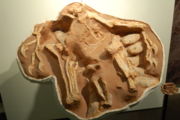 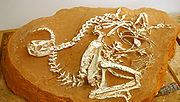 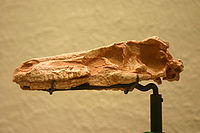 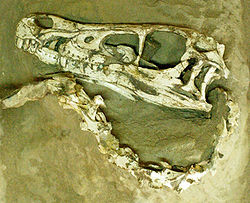 |
|
Archaeornithoides Archaeornithoides Archaeornithoides is a genus of maniraptoriform theropod dinosaur. It was found in Late Cretaceous river sandstones of the Djadokhta Formation beds located in Bayn Dzak, Mongolia... |
A. deinosauriscus |
|
"Partial skull." |
A coelurosaur of uncertain relationships |
||
Byronosaurus Byronosaurus Byronosaurus is a genus of troodontid dinosaur which lived during the Late Cretaceous Period. It was named for Byron Jaffe, "in recognition of his family's support for the Mongolian Academy of Sciences-American Museum of Natural History Paleontological Expeditions." The first example of... |
B. jaffei |
|
"Skull and fragmentary postcranium, [and a] fragmentary skull." |
A troodontid Troodontidae Troodontidae is a family of bird-like theropod dinosaurs. During most of the 20th century, troodontid fossils were few and scrappy and they have therefore been allied, at various times, with many dinosaurian lineages... |
||
Citipati Citipati Citipati is a genus of oviraptorid theropod dinosaur from the Late Cretaceous Period of what is now Mongolia . It is one of the best-known oviraptorids, thanks to a number of well-preserved skeletons, including several specimens found in brooding positions atop nests of eggs... |
C. osmolskae |
|
"Skeleton with skull, partial postcranium, embryo to adult." |
An oviraptorid Oviraptoridae Oviraptoridae is a group of bird-like, herbivorous and omnivorous maniraptoran dinosaurs. Oviraptorids are characterized by their toothless, parrot-like beaks and, in some cases, elaborate crests. They were generally small, measuring between one and two metres long in most cases, though some... found brooding its eggs |
||
Citipati sp. |
|
An oviraptorid with a distinctive, tall crest |
||||
Khaan Khaan Khaan was an oviraptorid dinosaur that was found in the Djadochta Formation of Mongolia and lived in the Late Cretaceous Period , 75 million years ago.... |
K. mckennai |
|
"[Three] skeletons with skulls." |
An oviraptorid |
||
Kol Kol (dinosaur) Kol is a genus of alvarezsaurid theropod dinosaur from the Late Cretaceous of Mongolia. The type specimen was excavated from the Ukhaa Tolgod locality of the Djadochta Formation, dating to about 75 million years ago. It is believed to have been about twice the size of the contemporary Shuvuuia... |
K. ghuva |
|
An alvarezsaurid Alvarezsauridae Alvarezsauridae is an enigmatic family of small, long-legged running dinosaurs. Although originally thought to represent the earliest known flightless birds, a consensus of recent work suggests that they are primitive members of the Maniraptora. Other work found them to be the sister group to the... |
|||
Mahakala Mahakala (dinosaur) Mahakala is a genus of basal dromaeosaurid dinosaur from the Campanian-age Upper Cretaceous Djadokhta Formation of Ömnögov, Mongolia. It is based on a partial skeleton found in the Gobi Desert... |
M. omnogovae |
|
A dromaeosaurid Dromaeosauridae Dromaeosauridae is a family of bird-like theropod dinosaurs. They were small- to medium-sized feathered carnivores that flourished in the Cretaceous Period. The name Dromaeosauridae means 'running lizards', from Greek dromeus meaning 'runner' and sauros meaning 'lizard'... |
|||
Oviraptor Oviraptor Oviraptor is a genus of small Mongolian theropod dinosaur, first discovered by the paleontologist Roy Chapman Andrews, and first described by Henry Fairfield Osborn, in 1924... |
O. philoceratops |
|
"[One] partial skeleton with skull" |
An oviraptorid. |
||
?Parvicursor Parvicursor Parvicursor is a genus of tiny maniraptoran dinosaur with long slender legs for fast running. At only about 39 cm from snout to end of tail, and 162 grams in weight, it is one of the smallest non-avian dinosaurs known from an adult specimen.Like other members of the family Alvarezsauridae,... |
Indeterminate |
|
An alvarezsaurid. |
|||
Quaesitosaurus Quaesitosaurus Quaesitosaurus is a genus of titanosaurian sauropod found by Kurzanov and Bannikov in 1983. The type species is Quaesitosaurus orientalis. It lived from 85 to 70 million years ago during the Late Cretaceous... |
Q. orientalis |
"Partial skull." |
||||
Saurornithoides Saurornithoides Saurornithoides is a genus of troodontid maniraptoran dinosaur, living during the Late Cretaceous period. These creatures were predators, which could run fast on their hind legs and had excellent sight and hearing... |
S. mongoliensis |
|
"Skull with fragmentary postcranial skeleton." |
A troodontid. |
||
Shuvuuia Shuvuuia Shuvuuia is a genus of bird-like theropod dinosaur from the late Cretaceous period of Mongolia. It is a member of the family Alvarezsauridae, small coelurosaurian dinosaurs which are characterized by short but powerful forelimbs specialized for digging. The type species is Shuvuuia deserti, or... |
S. deserti |
|
"Skull and postcranial skeleton." |
An alvarezsaurid |
||
Tyrannosauridae Tyrannosauridae Tyrannosauridae is a family of coelurosaurian theropod dinosaurs which comprises two subfamilies containing up to six genera, including the eponymous Tyrannosaurus. The exact number of genera is controversial, with some experts recognizing as few as three... indet. |
Indeterminate |
|
A tyrannosaurid Tyrannosauridae Tyrannosauridae is a family of coelurosaurian theropod dinosaurs which comprises two subfamilies containing up to six genera, including the eponymous Tyrannosaurus. The exact number of genera is controversial, with some experts recognizing as few as three... possible referable to Tarbosaurus. |
|||
Tsaagan Tsaagan Tsaagan is a genus of carnivorous dromaeosaurid theropod dinosaur from the Djadokhta Formation of the late Cretaceous of Mongolia.... |
T. mangas |
|
A dromaeosaurid |
|||
Velociraptor Velociraptor Velociraptor is a genus of dromaeosaurid theropod dinosaur that existed approximately 75 to 71 million years ago during the later part of the Cretaceous Period. Two species are currently recognized, although others have been assigned in the past. The type species is V. mongoliensis; fossils... |
V. mongoliensis |
|
A dromaeosaurid. |
|||
Unnamed dromaeosaurid |
Unnamed |
|
||||
|
Unnamed troodontid |
Unnamed, specimen IGM 100/1005 |
|
||||
See also
- Barun Goyot FormationBarun Goyot FormationThe Barun Goyot Formation , dating from the Late Cretaceous Period, is located within and is widely represented in the Gobi Desert basin, in the Ömnögovi Province of Mongolia....
- List of fossil sites (with link directory)
- Nemegt FormationNemegt FormationThe Nemegt Formation is a geological formation dating from the Late Cretaceous sedimentary from the Gobi Desert of Mongolia. It overlies and sometimes forms folds with the Barun Goyot Formation. It consists of river channel sediments and contains fossils of fish, turtles, crocodilians, birds and a...
- List of dinosaur-bearing rock formations

